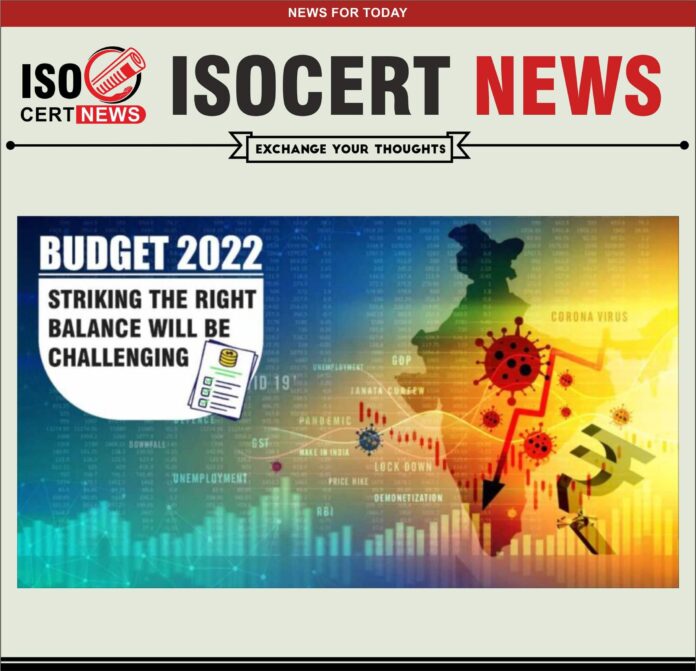The budget should be prudent and not overestimate populist measures such as direct transfers, subsidies, and other measures prior to the election.
Indian GDP growth has recovered from a contraction of 7.3% last year to over 9% next year. This growth has been driven primarily by government spending, exports driven by overseas recovery, and a falling rupee. Even the private sector has begun to accelerate. However, consumption, which accounts for almost 55% of GDP, falls 3% behind pre-pandemic levels. To maintain growth, consumption has to recover.
But there are some barriers along the way. First, inflation was disrupted by crude oil, product prices, pandemic supply, demand imbalances, and a surge in demand as economies opened up. While the 5.5 percent CPI lies within the comfort zone of the RBI, WPI of 13.56% is at its peak and suggests that consumer prices will increase in the future as companies continue to pass on higher input costs. Rural and middle-class households tend to have higher price elasticities and, as a result, inflation has eroded their consumption activity. This is reflected in the stagnation of tractor sales, which is seen as a proxy for the rural economy.
Moreover, local restrictions imposed by the Omicron the new coronavirus variant threatens the revenue and employment of low-income households. Consumption of these sections was reduced because of their relatively higher income elasticity.
Meanwhile, equity markets fluctuate around 17,000, up from 14,000 levels just before the pandemic. At the same time, Indian unicorns are expanding exponentially, as is the number of billionaires. This indicates a K-shaped retrieval. To prevent this, which is to make the economic recovery more widespread, the budget 2022 should include measures that will benefit rural and other low-income households. It is also expected that the government will get some sticking points before the next elections to the Assembly.
A BURNING ISSUE CONCERNING FUEL PRICES:
Geopolitical pressures in OPEC countries have aggravated crude oil prices. As global crude oil inventories decline, economies open and supply chain issues remain unresolved, experts expect crude oil to reach $100/bbl. by the end of 2022.
This is not a good time for the government, as higher fuel costs could deprive voters of the government of the day, despite recent tax cuts. To date, OLMCs have not passed on recent increases – domestic fuel prices have remained at the same levels since 2nd December. However, if they shifted gears and began to pass on the increment, it would increase expectations for further tax cuts.
If the next budget is fiscally prudent, there should be no reduction in fuel taxes. However, as fuel prices increase and OMC margins contract, the government may need to hit the nail on the head.
A LONG-TERM PERSPECTIVE ON POPULIST MEASURES:
The budget should be careful not to overestimate populist measures such as direct transfers, grants, and other measures before the election. Allocations for storage infrastructure and agricultural technology would rather be more productive to genuinely support the rural economy.
In addition, allocations should be increased expenditure with high multipliers, including infrastructure, logistics, and PLIs. Troubled industries, such as automotive and aviation, also require some relief. Health expenditure as a percentage of GDP is low and should also be supported by deficiencies in India’s health infrastructure that were highlighted during the pandemic. Announcements about the ease of doing business are also expected as the government attempts to attract foreign investment amid ongoing disputes over tariffs and disputes with foreign courts.
We can also expect funds to be allocated to clean energy initiatives, in order to continue to make progress towards India’s climate change goals, which have recently seen private sector participation accelerate.
FED MAKES THINGS MORE DIFFICULT FOR INDIA:
Maintaining growth is expected to remain the priority, especially in light of the US Fed’s monetary tightening announcements. The US Fed has expressed the possibility of rising hike rates since March, and at the same time putting an end to its bond purchases. Over time, US longer-term yields have already started to rise to 1.85% from 0.5% in August 2020.
This led to a narrowing of the spreads between US and Indian Treasury yields from 500 bps to 488 bps per month. As a result, India has seen enormous outflows of capital. The RBI should follow suit by increasing rates in a way that stops the narrowing of the gap, slows (or even reverses) capital outflows and controls inflation.
But, in order to do this, as RBI iterated in its last policy review, we need to grow broader and sustainably in the future, even as pent-up demand and weak baseline effects decline.
AN ACT OF BALANCE:
Of course, there are a number of expectations. But they should be undermined when we consider we already stretched budget deficit. FY22 budget had targeted a deficit of 6.8 percent of GDP, assuming lofty disinvestment targets of 1.75 trillion. The achievement against this objective was 455 billion rupees (including dividends), which is disappointing. Of course, if LIC’s mega IPO materializes before the end of the year, this would bring the figure reached to a higher level.
Of course, there would still be a shortfall, which would make this the third consecutive year it would not meet the target. Fortunately, tax collection was robust over the course of the year and should support the deficit to some extent. For FY23, experts report a monetary deficit exceeding 6 percent of GDP in accordance with the objective of the previous budget to control it at 4.5 % of GDP by fiscal year 26. Hopefully, the experience will guide the government toward lower divestment goals this year.
However, having said that, as long as the budget focuses on growth rather than populist measures, the long-term prospects for Indian equity markets remain good.










